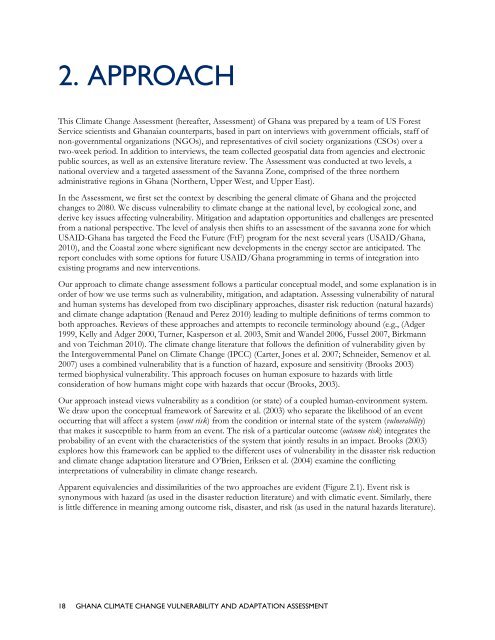ghana climate change vulnerability and adaptation assessment
ghana climate change vulnerability and adaptation assessment
ghana climate change vulnerability and adaptation assessment
- No tags were found...
You also want an ePaper? Increase the reach of your titles
YUMPU automatically turns print PDFs into web optimized ePapers that Google loves.
2. APPROACHThis Climate Change Assessment (hereafter, Assessment) of Ghana was prepared by a team of US ForestService scientists <strong>and</strong> Ghanaian counterparts, based in part on interviews with government officials, staff ofnon-governmental organizations (NGOs), <strong>and</strong> representatives of civil society organizations (CSOs) over atwo-week period. In addition to interviews, the team collected geospatial data from agencies <strong>and</strong> electronicpublic sources, as well as an extensive literature review. The Assessment was conducted at two levels, anational overview <strong>and</strong> a targeted <strong>assessment</strong> of the Savanna Zone, comprised of the three northernadministrative regions in Ghana (Northern, Upper West, <strong>and</strong> Upper East).In the Assessment, we first set the context by describing the general <strong>climate</strong> of Ghana <strong>and</strong> the projected<strong>change</strong>s to 2080. We discuss <strong>vulnerability</strong> to <strong>climate</strong> <strong>change</strong> at the national level, by ecological zone, <strong>and</strong>derive key issues affecting <strong>vulnerability</strong>. Mitigation <strong>and</strong> <strong>adaptation</strong> opportunities <strong>and</strong> challenges are presentedfrom a national perspective. The level of analysis then shifts to an <strong>assessment</strong> of the savanna zone for whichUSAID-Ghana has targeted the Feed the Future (FtF) program for the next several years (USAID/Ghana,2010), <strong>and</strong> the Coastal zone where significant new developments in the energy sector are anticipated. Thereport concludes with some options for future USAID/Ghana programming in terms of integration intoexisting programs <strong>and</strong> new interventions.Our approach to <strong>climate</strong> <strong>change</strong> <strong>assessment</strong> follows a particular conceptual model, <strong>and</strong> some explanation is inorder of how we use terms such as <strong>vulnerability</strong>, mitigation, <strong>and</strong> <strong>adaptation</strong>. Assessing <strong>vulnerability</strong> of natural<strong>and</strong> human systems has developed from two disciplinary approaches, disaster risk reduction (natural hazards)<strong>and</strong> <strong>climate</strong> <strong>change</strong> <strong>adaptation</strong> (Renaud <strong>and</strong> Perez 2010) leading to multiple definitions of terms common toboth approaches. Reviews of these approaches <strong>and</strong> attempts to reconcile terminology abound (e.g., (Adger1999, Kelly <strong>and</strong> Adger 2000, Turner, Kasperson et al. 2003, Smit <strong>and</strong> W<strong>and</strong>el 2006, Fussel 2007, Birkmann<strong>and</strong> von Teichman 2010). The <strong>climate</strong> <strong>change</strong> literature that follows the definition of <strong>vulnerability</strong> given bythe Intergovernmental Panel on Climate Change (IPCC) (Carter, Jones et al. 2007; Schneider, Semenov et al.2007) uses a combined <strong>vulnerability</strong> that is a function of hazard, exposure <strong>and</strong> sensitivity (Brooks 2003)termed biophysical <strong>vulnerability</strong>. This approach focuses on human exposure to hazards with littleconsideration of how humans might cope with hazards that occur (Brooks, 2003).Our approach instead views <strong>vulnerability</strong> as a condition (or state) of a coupled human-environment system.We draw upon the conceptual framework of Sarewitz et al. (2003) who separate the likelihood of an eventoccurring that will affect a system (event risk) from the condition or internal state of the system (<strong>vulnerability</strong>)that makes it susceptible to harm from an event. The risk of a particular outcome (outcome risk) integrates theprobability of an event with the characteristics of the system that jointly results in an impact. Brooks (2003)explores how this framework can be applied to the different uses of <strong>vulnerability</strong> in the disaster risk reduction<strong>and</strong> <strong>climate</strong> <strong>change</strong> <strong>adaptation</strong> literature <strong>and</strong> O’Brien, Eriksen et al. (2004) examine the conflictinginterpretations of <strong>vulnerability</strong> in <strong>climate</strong> <strong>change</strong> research.Apparent equivalencies <strong>and</strong> dissimilarities of the two approaches are evident (Figure 2.1). Event risk issynonymous with hazard (as used in the disaster reduction literature) <strong>and</strong> with climatic event. Similarly, thereis little difference in meaning among outcome risk, disaster, <strong>and</strong> risk (as used in the natural hazards literature).18 GHANA CLIMATE CHANGE VULNERABILITY AND ADAPTATION ASSESSMENT
















